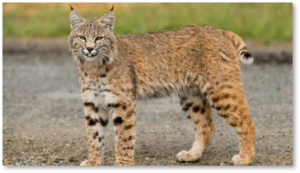Our living room looks out onto a berm above a retaining wall and my perennial border. The berm runs along behind the houses on this side of the street. Beyond that is a stone wall and then the rough around Charter Oak Country Club’s first green. The golf course has a lot of lovely open space with a ravine between the ninth and tenth fairways.
At some times during the year, the berm become a wildlife highway as critters of all kinds either parade around on it or get from one place to another quickly and easily. It’s like watching the fifties cars in American Graffiti cruising up and down the strip—only with fur and feathers instead of chrome.
The Turkey Parade
In spring, the wild turkeys do the parading with the big toms flaunting their plumage while the hens do their best to ignore them in favor of foraging for dinner. Smaller animals like chipmunks, squirrels and rabbits also use it although most prefer the greener grass below the retaining wall.
The neighborhood fox visits frequently, if not regularly, and last week I watched a coyote trot along the berm on his way south. Fisher cats occasionally run along the stone wall. I won’t mention the chipmunks, squirrels, and bunnies as they are ubiquitous.
The Bobcat Appears
This week, however, i got a surprise. While watching TV, I looked up to see a large Eastern Bobcat (Lynx rufus rufus) making his way north along the berm. He moved too fast for me to get a photo but I saw him jump onto the stone wall and use it as an easy path through the undergrowth.
Just to be clear, we do not live in the deep woods. We live in a quiet suburban town with a very nice 19th-century downtown that offers lovely shops and quite a few fine restaurants. Also, we live in a condominium community, not a remote house at the end of a long driveway.
Now, just in case you think I was just seeing the neighbor’s marmalade cat, I can tell you this feline was bigger than any domestic feline. He was certainly taller and longer than our own cat—and Mookie is a large kitty. Also, he moved like a wild creature. There was no hint of domesticity in his behavior.
Thinning the Ranks
When I researched him, however, I found that what I saw looked more like a Canada lynx. That’s unlikely, however, as they are much more rare and unlikely to be roaming around houses.
What encouraged me, however, is that the Eastern Bobcat feeds on mice, voles, rats, chipmunks, squirrels, cottontail rabbits, snowshoe hares, birds, and deer. Like coyotes, they are opportunists and will take almost any small animal. Well, we have a lot of small animals around here and I would be glad if the bobcat thinned the ranks of the ones who eat my tomato and pepper plants.
Waiting for the Bear
Every year, however, the wildlife gets a little closer, especially in the spring. We haven’t seen a bear yet, cocaine or otherwise, but I won’t be surprised when it happens. And it will happen.
Every year we get more reports of bears in suburban backyards, especially in the spring. That’s when yearling cubs get kicked out of the den to make room for a new crop of young ‘uns. The yearlings have to find a territory of their own and that just might be in someone’s backyard. Or on the golf course with the added benefit of cruising along the berm.
I keep the blinds up until it gets dark because I never know what we’re going to see out there.


